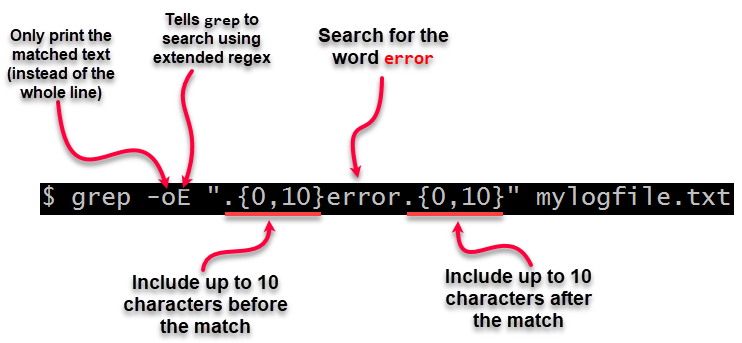Reputation: 45652
How to truncate long matching lines returned by grep or ack
I want to run ack or grep on HTML files that often have very long lines. I don't want to see very long lines that wrap repeatedly. But I do want to see just that portion of a long line that surrounds a string that matches the regular expression. How can I get this using any combination of Unix tools?
Upvotes: 134
Views: 62578
Answers (11)

Reputation: 383984
bgrep if lines don't necessarily fit into memory
grep only works if the lines fit into memory, but bgrep also works on huge lines that don't.
I keep coming back to this random repo from time to time: https://github.com/tmbinc/bgrep Install:
curl -L 'https://github.com/tmbinc/bgrep/raw/master/bgrep.c' | gcc -O2 -x c -o $HOME/.local/bin/bgrep -
Use:
bgrep `printf %s saf | od -t x1 -An -v | tr -d '\n '` myfile.bin
Sample output:
myfile.bin: c80000003
\x02abc
myfile.bin: c80000007
dabc
I have tested it on files that don't fit into memory, and it worked just fine.
I've given further details at: https://unix.stackexchange.com/questions/223078/best-way-to-grep-a-big-binary-file/758528#758528
Upvotes: 0

Reputation: 882
To get characters from 1 to 100.
cut -c 1-100
You might want to base the range off the current terminal, e.g.
cut -c 1-$(tput cols)
Upvotes: 17
Reputation: 11376
grep -oE ".{0,10}error.{0,10}" mylogfile.txt
In the unusual situation where you cannot use -E, use lowercase -e instead.
Upvotes: 21
Reputation: 53986
You could use the grep options -oE, possibly in combination with changing your pattern to ".{0,10}<original pattern>.{0,10}" in order to see some context around it:
-o, --only-matching
Show only the part of a matching line that matches PATTERN.
-E, --extended-regexp
Interpret pattern as an extended regular expression (i.e., force grep to behave as egrep).
For example (from @Renaud's comment):
grep -oE ".{0,10}mysearchstring.{0,10}" myfile.txt
Alternatively, you could try -c:
-c, --count
Suppress normal output; instead print a count of matching lines
for each input file. With the -v, --invert-match option (see
below), count non-matching lines.
Upvotes: 127

Reputation: 44019
The Silver Searcher (ag) supports its natively via the --width NUM option. It will replace the rest of longer lines by [...].
Example (truncate after 120 characters):
$ ag --width 120 '@patternfly'
...
1:{"version":3,"file":"react-icons.js","sources":["../../node_modules/@patternfly/ [...]
In ack3, a similar feature is planned but currently not implemented.
Upvotes: 2

Reputation: 1170
ag can also take the regex trick, if you prefer it:
ag --column -o ".{0,20}error.{0,20}"
Upvotes: 0
Reputation: 884
Here's what I do:
function grep () {
tput rmam;
command grep "$@";
tput smam;
}
In my .bash_profile, I override grep so that it automatically runs tput rmam before and tput smam after, which disabled wrapping and then re-enables it.
Upvotes: 1
Reputation: 199
I put the following into my .bashrc:
grepl() {
$(which grep) --color=always $@ | less -RS
}
You can then use grepl on the command line with any arguments that are available for grep. Use the arrow keys to see the tail of longer lines. Use q to quit.
Explanation:
grepl() {: Define a new function that will be available in every (new) bash console.$(which grep): Get the full path ofgrep. (Ubuntu defines an alias forgrepthat is equivalent togrep --color=auto. We don't want that alias but the originalgrep.)--color=always: Colorize the output. (--color=autofrom the alias won't work sincegrepdetects that the output is put into a pipe and won't color it then.)$@: Put all arguments given to thegreplfunction here.less: Display the lines usingless-R: Show colorsS: Don't break long lines
Upvotes: 3

Reputation: 93755
Pipe your results thru cut. I'm also considering adding a --cut switch so you could say --cut=80 and only get 80 columns.
Upvotes: 58
Reputation: 9370
Taken from: http://www.topbug.net/blog/2016/08/18/truncate-long-matching-lines-of-grep-a-solution-that-preserves-color/
The suggested approach ".{0,10}<original pattern>.{0,10}" is perfectly good except for that the highlighting color is often messed up. I've created a script with a similar output but the color is also preserved:
#!/bin/bash
# Usage:
# grepl PATTERN [FILE]
# how many characters around the searching keyword should be shown?
context_length=10
# What is the length of the control character for the color before and after the
# matching string?
# This is mostly determined by the environmental variable GREP_COLORS.
control_length_before=$(($(echo a | grep --color=always a | cut -d a -f '1' | wc -c)-1))
control_length_after=$(($(echo a | grep --color=always a | cut -d a -f '2' | wc -c)-1))
grep -E --color=always "$1" $2 |
grep --color=none -oE \
".{0,$(($control_length_before + $context_length))}$1.{0,$(($control_length_after + $context_length))}"
Assuming the script is saved as grepl, then grepl pattern file_with_long_lines should display the matching lines but with only 10 characters around the matching string.
Upvotes: 2
Reputation: 4385
You could use less as a pager for ack and chop long lines: ack --pager="less -S" This retains the long line but leaves it on one line instead of wrapping. To see more of the line, scroll left/right in less with the arrow keys.
I have the following alias setup for ack to do this:
alias ick='ack -i --pager="less -R -S"'
Upvotes: 29
Related Questions
- How to truncate rest of the text in a file after finding a specific text pattern, in unix?
- How to trim specific text with grep
- How to limit the number of characters returned by each match in grep
- How to exclude several lines around match with grep or similar tool?
- Bash: How to shorten long lines of a log file whilst keeping a fixed number of characters from beginning and end of each line?
- How to output lines longer than a specified number of words in Bash using awk or grep
- Find lines longer than x characters and truncate for display
- truncate shell command output from last line matching a string until EOF
- How can a grep for a specific field and less the entire line
- Bash - ack - limit length of matched line
